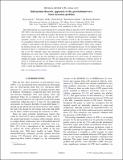Information-theoretic approach to the gravitational-wave burst detection problem
Author(s)
Katsavounidis, Erik; Robinet, Florent; Lynch, Ryan Christopher; Vitale, Salvatore; Essick, Reed Clasey
DownloadPhysRevD.95.104046.pdf (2.422Mb)
PUBLISHER_POLICY
Publisher Policy
Article is made available in accordance with the publisher's policy and may be subject to US copyright law. Please refer to the publisher's site for terms of use.
Terms of use
Metadata
Show full item recordAbstract
The observational era of gravitational-wave astronomy began in the fall of 2015 with the detection of GW150914. One potential type of detectable gravitational wave is short-duration gravitational-wave bursts, whose waveforms can be difficult to predict. We present the framework for a detection algorithm for such burst events—oLIB—that can be used in low latency to identify gravitational-wave transients. This algorithm consists of (1) an excess-power event generator based on the Q transform—Omicron—, (2) coincidence of these events across a detector network, and (3) an analysis of the coincident events using a Markov chain Monte Carlo Bayesian evidence calculator—LALInferenceBurst. These steps compress the full data streams into a set of Bayes factors for each event. Through this process, we use elements from information theory to minimize the amount of information regarding the signal-versus-noise hypothesis that is lost. We optimally extract this information using a likelihood-ratio test to estimate a detection significance for each event. Using representative archival LIGO data across different burst waveform morphologies, we show that the algorithm can detect gravitational-wave burst events of astrophysical strength in realistic instrumental noise. We also demonstrate that the combination of Bayes factors by means of a likelihood-ratio test can improve the detection efficiency of a gravitational-wave burst search. Finally, we show that oLIB’s performance is robust against the choice of gravitational-wave populations used to model the likelihood-ratio test likelihoods.
Date issued
2017-05Department
Massachusetts Institute of Technology. Department of Physics; MIT Kavli Institute for Astrophysics and Space ResearchJournal
Physical Review D
Publisher
American Physical Society
Citation
Lynch, Ryan, Salvatore Vitale, Reed Essick, Erik Katsavounidis, and Florent Robinet. “Information-Theoretic Approach to the Gravitational-Wave Burst Detection Problem.” Physical Review D 95, no. 10 (May 30, 2017).
Version: Final published version
ISSN
2470-0010
2470-0029